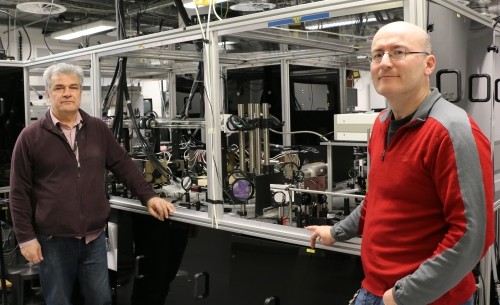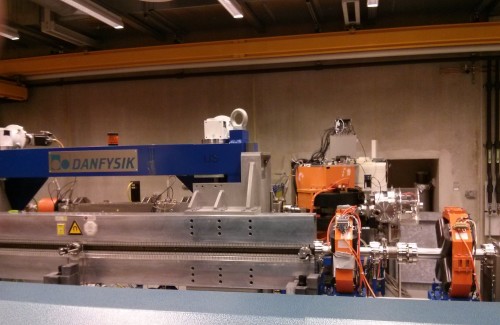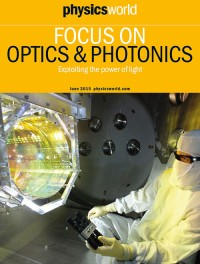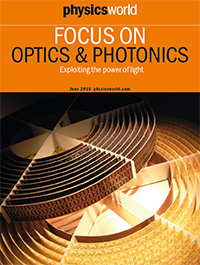Tag archives: lasers
Prize-winning astronomy image, the ultimate cost of Cassini, amazing facts about lasers

Prize winning: the Rho Ophiuchi Cloud Complex captured by Artem Mironov (Courtesy: Artem Mironov)
By Hamish Johnston and Michael Banks
Hats off to the Russian photographer Artem Mironov, who has beaten thousands of amateur and professional photographers from around the world to win the 2017 Insight Astronomy Photographer of the Year. The award is in its ninth year and is run by the Royal Observatory Greenwich together with Insight Investment and BBC Sky at Night magazine. Mironox’s image, which was taken over three nights from a farm in Namibia, is of the swirling dust and gas clouds in the Rho Ophiuchi Cloud Complex. The object is situated approximately 400 light years away from Earth and is home to a cluster of more than 300 protostars. As well as winning the £10,000 top prize, Mironov’s image will be on display along with other selected pictures at an exhibition at the Royal Observatory that will run until 28 June 2018. The competition received over 3800 entries from over 90 countries. (more…)
View all posts by this author | View this author's profile
A century ago Einstein sparked the notion of the laser

Another brilliant idea: laser beams illuminate fog. (CC BY 2.0/ Jeff Keyzer)
By Philip Ball
I just got back from having my broken wrist X-rayed (it’s doing fine, thanks), and noticed that a laser beam was used to position and align the X-ray source. Hardly the most sophisticated use of these optical devices, it’s true, but a little reminder that there’s probably hardly a day goes by in the life of an average urbanite without the laser’s beam of coherent photons impinging on it. From supermarket barcode scanning to broadband fibre-optic telecommunications, lasers are everywhere.
The fundamental idea behind this mainstay of modern life was published one hundred years ago by Albert Einstein. But blink and you’ll miss it in his seminal paper, “The quantum theory of radiation”, published in German in Physikalische Zeitschrift 18 121 (English translation here). Einstein is trying to work out what Max Planck’s “quantum hypothesis” – that the energy of an oscillator must take discrete values equal to some integer multiple of the oscillation frequency times a constant h – implies for the way light interacts with matter.
View all posts by this author | View this author's profile
Visiting the most powerful laser in the world
By James Dacey
You might find this surprising, but Romania is one of the main reasons I became a journalist. Back in 2006, having recently graduated with a degree in natural sciences, I spent the summer in the Transylvanian city of Brasov, teaching English to school kids. While there, I was talked into writing a few articles about my experiences for the local tourism magazine, Brasov Visitor. To cut a rambling story short, I had a memorable summer and caught the writing bug. Eventually, I landed a job at Physics World, which enabled me to combine my journalistic leanings with my scientific background.
View all posts by this author | View this author's profile
Terahertz analytics for better plasmas

Terahertz generators: Gianqian Liao (left) and Yutong Li.
By Hamish Johnston in Beijing
Today was the last day of the Fall Meeting of the Chinese Physical Society here in Beijing and this morning I grabbed a coffee with Yutong Li and Giuqian Liao. I was hoping to learn more about their work that we covered in May in “Coherent terahertz radiation created in laser plasmas“.
Their technique involves firing a powerful laser pulse at a thin metal foil. This creates a plasma in which electrons are accelerated to high energies before bursting out of the foil. When they emerge, coherent terahertz radiation is given off.
View all posts by this author | View this author's profile
Celtic god of thunder gets an attosecond makeover

Gods of thunder: Gagik Nersisyan (left) and Matt Zepf at the TARANIS laser facility.
By Hamish Johnston
I recently had the pleasure of visiting Matt Zepf, who directs the Centre for Plasma Physics at Queen’s University Belfast. Zepf and his colleague Gagik Nersisyan showed me around the TARANIS laser facility, which creates extremely bright flashes of light just like its namesake the Celtic god of thunder.
TARANIS is about to upgraded to TARANIS-X, which will deliver ultrashort pulses of extreme ultraviolet light (EUV) that are just a few attoseconds (10–18 s) in duration. Each attosecond pulse will deliver more than 10 µJ, which Zepf says will make TARANIS-X the most powerful laser of its kind by a comfortable margin.
View all posts by this author | View this author's profile
Making noise in the quietest room in the Netherlands

Wiggling electrons: an undulator at one of FELIX’s free-electron lasers.
By Tim Wogan in Nijmegen, the Netherlands
Tucked away near the German border is the Dutch city of Nijmegen and Radboud University, which has a treasure trove of fantastical physics facilities. I was in town for a two-day, whistle-stop tour of the university that included the the opening of the FELIX facility. FELIX stands for “free-electron laser for infrared experiments laboratory”. It is a cavernous chamber housing four free-electron lasers that together can generate high-intensity, tunable radiation with wavelengths anywhere between 3–1500 μm. Something, I was told, that is possible nowhere else in the world.
Laser show lights up Institute of Physics awards dinner

Light me up – the 2015 Institute of Physics awards dinner got off to a spectacular start last night. (Courtesy: Institute of Physics)
By Matin Durrani
And so to London last night to attend the annual awards dinner of the Institute of Physics, which publishes Physics World.
It’s a time when the Institute recognizes physicists who are making a “remarkable contribution” to physics, with awards going to teachers, researchers and businesses – as well as those who’ve served the Institute, shown best practice in professional development, and the university departments that have tackled the under-representation of women in physics. International awards are given too.
It being the International Year of Light, guests were also treated to two spectacular stage shows. Having just settled into our seats, we first watched as three dancers performed in front of lasers, dry ice and strobe lighting (see photo above) – certainly a first for an Institute awards dinner – while after the meal we were treated to a troupe called Feeding the Fish.
Their dancers carry laser batons to create “one-of-a-kind performances that fuse tight choreography with…specialized lighting effects”, with the batons being used to show everything from triangles and butterflies to even the logo of the Institute of Physics. Quite how it all worked certainly had physicists in the audience scratching their heads.
View all posts by this author | View this author's profile
Horsing around with some innovative physics

(Left to right) Physicists Giedre Podolyak, Steve Roberts and Snezhana Chater of Hallmarq Veterinary Imaging celebrate their success in the IOP Innovation Awards.
By Margaret Harris
Imagine you’re a veterinarian and a trainer asks you to take a look at a horse. The animal, a champion showjumper, is limping slightly but there is no obvious injury. Exploratory surgery would probably do more harm than good, and the alternative – magnetic resonance imaging (MRI) – isn’t risk-free either. You’d need to put the horse under a general anaesthetic, and you know horses don’t react well to that; in fact, around 0.5% suffer serious injuries while coming round afterwards. And that’s assuming you can even find a scanner big enough to fit a horse. What do you do?
This might sound like a fairly niche dilemma, but for Hallmarq Veterinary Imaging it has become the basis for a thriving business – a business, moreover, that has just won an IOP Innovation Award for the successful application of physics in a commercial product.
At the awards ceremony – which took place last night in the Palace of Westminster, London, just down the hall from the House of Commons chamber – I caught up with Hallmarq’s operations and technical director, Steve Roberts. After sketching out the scenario of the veterinarian and the injured horse, Roberts, a physicist, explained that Hallmarq’s MRI scanner fits around the horse’s leg. This means that equine patients can simply be led into it, sedated but conscious. Sophisticated error-correction and image-processing software helps the scanner compensate for the horse’s movement, and in 15 years of operation, Roberts estimates that veterinarians have used Hallmarq’s machines to scan more than 60,000 horses.
Physics World 2015 Focus on Optics & Photonics is out now
 By Matin Durrani
By Matin Durrani
With the 2015 International Year of Light now in full swing, it’s time to tuck into the latest focus issue of Physics World, which explores some of the latest research into optics and photonics.
The focus issue, which can be read here free of charge, kicks off by looking at the giant laser interferometers underpinning the latest searches for gravitational waves. We also report on recent efforts to use optical instead of radio waves for satellite communication and have an interview with Ian Walmsley from the University of Oxford about the vital role that optics and photonics play in the UK’s new £270m Quantum Technologies Programme.
View all posts by this author | View this author's profile
 By Matin Durrani
By Matin Durrani